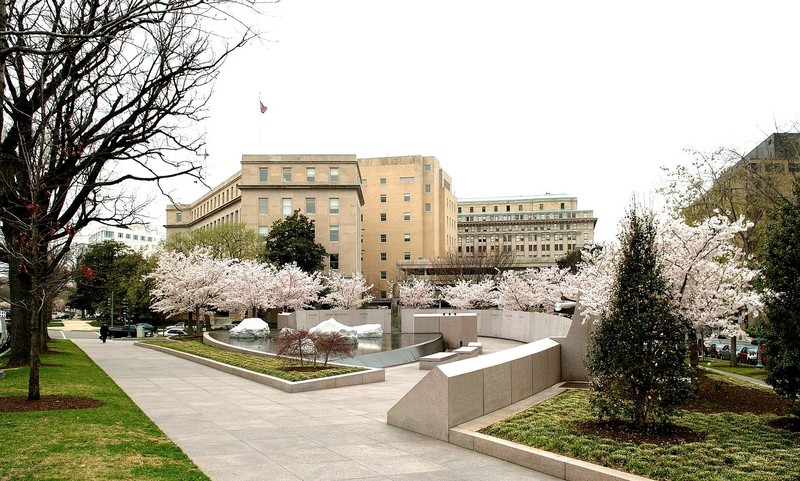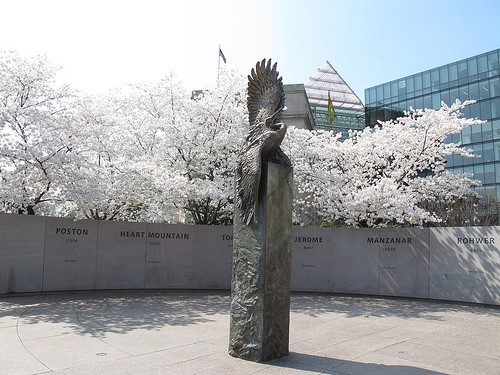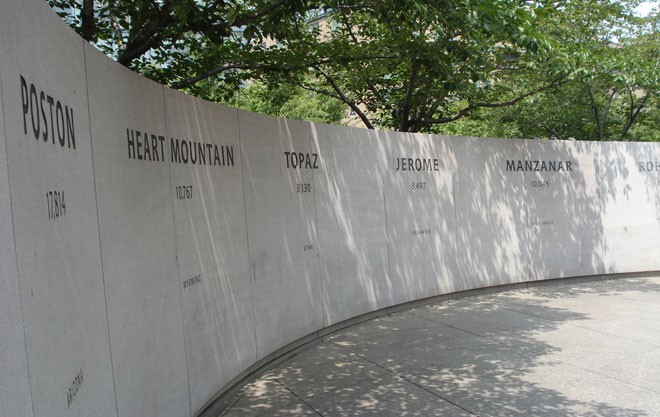Japanese American Memorial to Patriotism During World War II
Introduction
Text-to-speech Audio
Images
Japanese American Memorial to Patriotism During World War II

Nina Akamu's bronze sculpture of two cranes entangled in barbed-wire resting on a green Vermont marble pedestal

The names of the internment camps and their populations engraved in the stone panels

The reflecting pool at the memorial
.jpg)
Backstory and Context
Text-to-speech Audio
In the wake of the Japanese attack on Pearl Harbor and America’s subsequent entry into the Second World War, officials within the U.S. War Department expressed concerns about the loyalty of Japanese Americans. They feared that people of Japanese ancestry living in the United States might actively undermine the American war effort by operating as spies or saboteurs for Japan. Sharing these feelings, some political leaders proposed the idea of forcibly relocating Japanese Americans living on the West Coast to inland detention centers, where they could be closely monitored. At the time, roughly 125,000 Japanese Americans were living on the U.S. mainland. Some, known as Issei, were born in Japan and later immigrated to the United States, while the majority, called Nisei, were born in the United States and therefore U.S. citizens.
Before long, the Department of Justice and the War Department clashed over how to handle the perceived threat. The latter advocated for forced relocation and internment, while the former strongly objected to the idea. In the end, the War Department’s stance won out when President Franklin Delano Roosevelt signed Executive Order 9066 on February 19, 1942. The following month, the War Relocation Authority (WRA) was established to oversee the relocation and internment of Japanese Americans living on the West Coast.
The WRA then ordered all Japanese Americans living on the West Coast to report to control stations and register their names and the names of all their family members. After completing the registration process, Japanese Americans learned of when and where they needed to report for relocation to an internment camp. The WRA provided them anywhere from a few days to a few weeks to settle their affairs and pack up their belongings, bringing with them only what they could carry. Many were forced to sell their businesses, homes, and automobiles.
Between 1942 and 1945, the WRA opened ten internment camps. Located throughout the American West in states such as Arizona, California, Colorado, Utah, and Wyoming, the camps were surrounded by tall, barbed-wire fences patrolled by armed guards at all times. Inside the camps, Japanese Americans lived in uninsulated barracks and shared bathroom and laundry facilities. The WRA, however, permitted families to live together and allowed internees to setup churches and schools, play sports, and even publish their own newspapers. In all, approximately 120,000 Japanese Americans were interned during the Second World War.
Not surprisingly, legal challenges arose to the federal government’s actions. In 1944, the United States Supreme Court’s ruling in Korematsu v. United States upheld Japanese internment. However, the Court ruled in an ex parte decision that the U.S. government could not detain a U.S. citizen without charge if it concedes that the citizen is loyal to the United States. Even before the ex parte ruling, the U.S. government had been investigating those Japanese Americans held in internment camps very closely. Those it deemed loyal were allowed—among other things—to enlist in the U.S. Army. Ultimately, more than 33,000 Japanese Americans served during the Second World War and over 800 made the ultimate sacrifice.
In December 1944, before the war had ended, the U.S. government announced that all internment camps would close by the end of 1945. It took until March 1946, however, for the last one to shutter. More than three decades later, President Gerald Ford officially repealed Executive Order 9066 in 1976. Twelve years later, in 1988, Congress issued a formal apology for Japanese internment and passed the Civil Liberties Act, which gave each survivor $20,000 as reparation.
One year before the passage of the Civil Liberties Act, the Smithsonian Institution’s National Museum of American History opened a new exhibit entitled A More Perfect Union: Japanese Americans and the U.S. Constitution. The exhibit inspired the formation of the Go For Broke National Veterans Association in 1989. The mission of the organization was to erect a national memorial dedicated to Japanese American war veterans. The National Capital Memorial Advisory Commission, however, ruled that the group’s proposal violated the Commemorative Works Act, which outlawed the construction of war memorials dedicated to specific ethnic groups. Months later, however, a compromise was reached. The commission would allow the memorial to be built so long as it dedicated to Japanese American patriotism during the Second World War, instead of specifically to Japanese American war veterans. In 1992, President George H.W. Bush signed a bill into law that authorized the construction of the memorial. In response, the Go For Broke National Veterans Association renamed itself the National Japanese American Memorial Foundation and forged ahead with planning the memorial. Ultimately, the organization raised $13 million for the construction of the memorial and selected D.C. architect Davis Buckley to design it.
Located on a three-quarter-acre plot of land at the intersection of Louisiana Avenue, New Jersey Avenue, and D Street NW, the memorial was dedicated on November 9, 2000 and opened to the public several months later. It features a bronze sculpture of two cranes breaking free from barbed wire, a reflecting pool with five granite boulders, a sixteen-foot-long tube-shaped bell, and many large stone panels that serve to enclose the space. The sculpture was designed by artist Nina Akamu, a third-generation Japanese American. Inscribed into the panels are the names of the ten internment camps, the number of Japanese Americans held there, and the names of those Japanese Americans who gave their lives while serving in the U.S. military during the war.
Sources
"About the Foundation." National Japanese American Memorial Foundation. Web. 12 February 2021 <https://www.njamemorial.org/about>.
"About the Memorial." National Japanese American Memorial Foundation. Web. 12 February 2021 <https://www.njamemorial.org/new-page-1>.
Axelrod, Alan. Encyclopedia of World War II. Edited by Jack A. Kingston. Vol. 1. New York: Facts On File, 2007.
History.com Editors. "Japanese Internment Camps." History. A&E Television Networks. 21 February 2020. Web. 12 February 2021 <https://www.history.com/topics/world-war-ii/japanese-american-relocation#section_12>.
"Japanese American Internment." Encyclopædia Britannica. Web. 12 February 2021 <https://www.britannica.com/event/Japanese-American-internment>.
"National Japanese American Memorial to Patriotism During World War II." Densho Encyclopedia. Web. 12 February 2021 <https://encyclopedia.densho.org/National%20Japanese%20American%20Memorial%20to%20Patriotism%20During%20World%20War%20II>.
https://www.aptdc.org/event-2558652
https://www.popville.com/2012/03/memorial-to-japanese-american-patriotism-in-world-war-ii/
https://www.asla.org/Guide/site.aspx?id=35744
https://commons.wikimedia.org/wiki/File:Japanese_American_Memorial_to_Patriotism_During_World_War_II_(7069e7d1-ea30-44ce-a317-e7916b88a017).jpg
